INF 80018: Reviewing Enterprise Architecture, Strategy & Governance
VerifiedAdded on 2023/06/12
|12
|3330
|112
Essay
AI Summary
This essay provides a comprehensive overview of enterprise architecture (EA) and its governance, highlighting its importance for organizational success. It discusses traditional theories from various authors, offering a solid understanding of EA concepts and frameworks like ZF and TOGAF. The report also addresses EA features that simplify processes, reasons for project failures, and the necessary skills for an enterprise architect. The essay emphasizes the role of stakeholders, the importance of IT alignment with business goals, and the need for effective communication and review processes. It concludes by underscoring EA's value in optimizing IT investments and ensuring that technology supports business objectives. Desklib provides similar solved assignments for students.
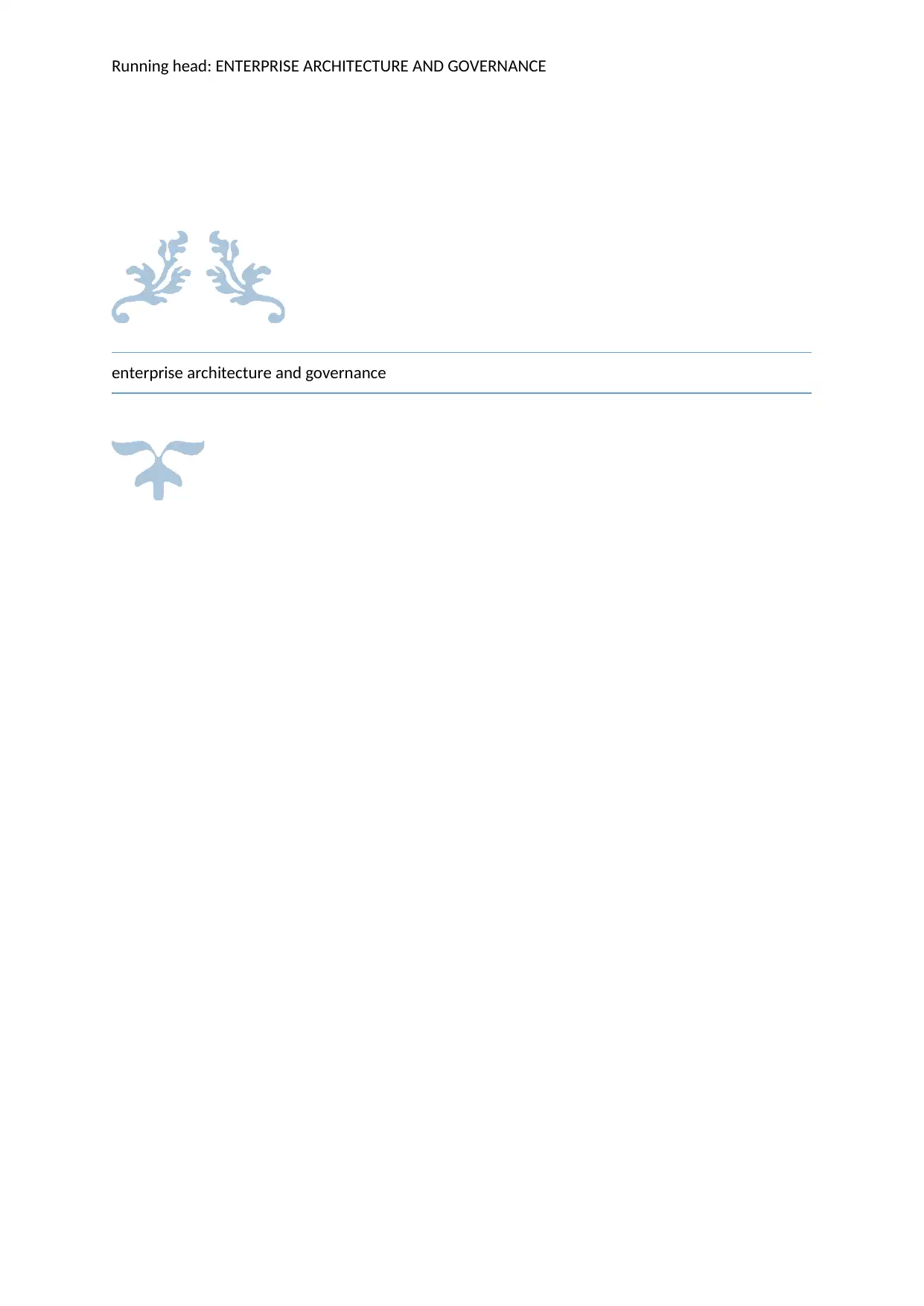
Running head: ENTERPRISE ARCHITECTURE AND GOVERNANCE
enterprise architecture and governance
enterprise architecture and governance
Paraphrase This Document
Need a fresh take? Get an instant paraphrase of this document with our AI Paraphraser
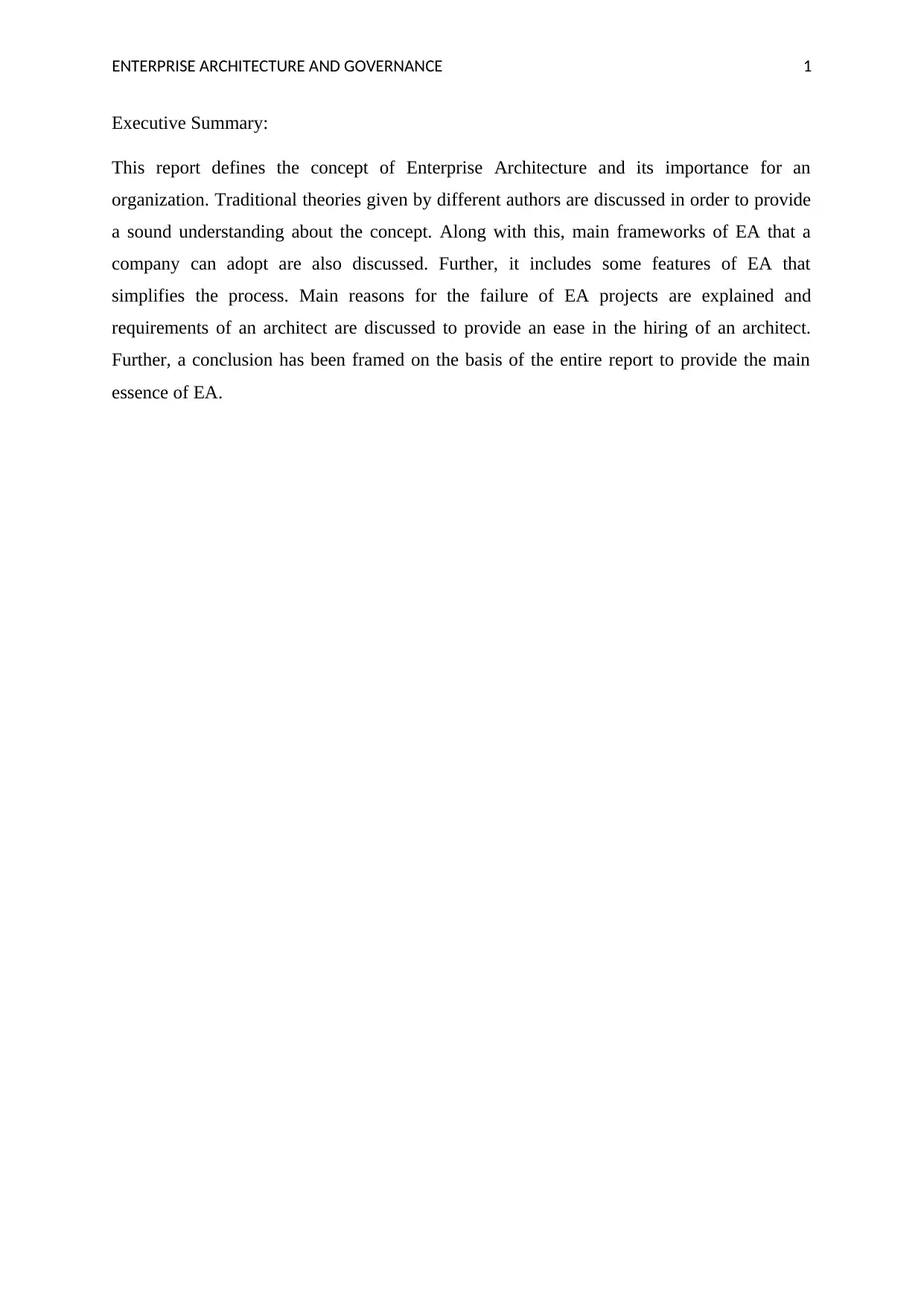
ENTERPRISE ARCHITECTURE AND GOVERNANCE 1
Executive Summary:
This report defines the concept of Enterprise Architecture and its importance for an
organization. Traditional theories given by different authors are discussed in order to provide
a sound understanding about the concept. Along with this, main frameworks of EA that a
company can adopt are also discussed. Further, it includes some features of EA that
simplifies the process. Main reasons for the failure of EA projects are explained and
requirements of an architect are discussed to provide an ease in the hiring of an architect.
Further, a conclusion has been framed on the basis of the entire report to provide the main
essence of EA.
Executive Summary:
This report defines the concept of Enterprise Architecture and its importance for an
organization. Traditional theories given by different authors are discussed in order to provide
a sound understanding about the concept. Along with this, main frameworks of EA that a
company can adopt are also discussed. Further, it includes some features of EA that
simplifies the process. Main reasons for the failure of EA projects are explained and
requirements of an architect are discussed to provide an ease in the hiring of an architect.
Further, a conclusion has been framed on the basis of the entire report to provide the main
essence of EA.
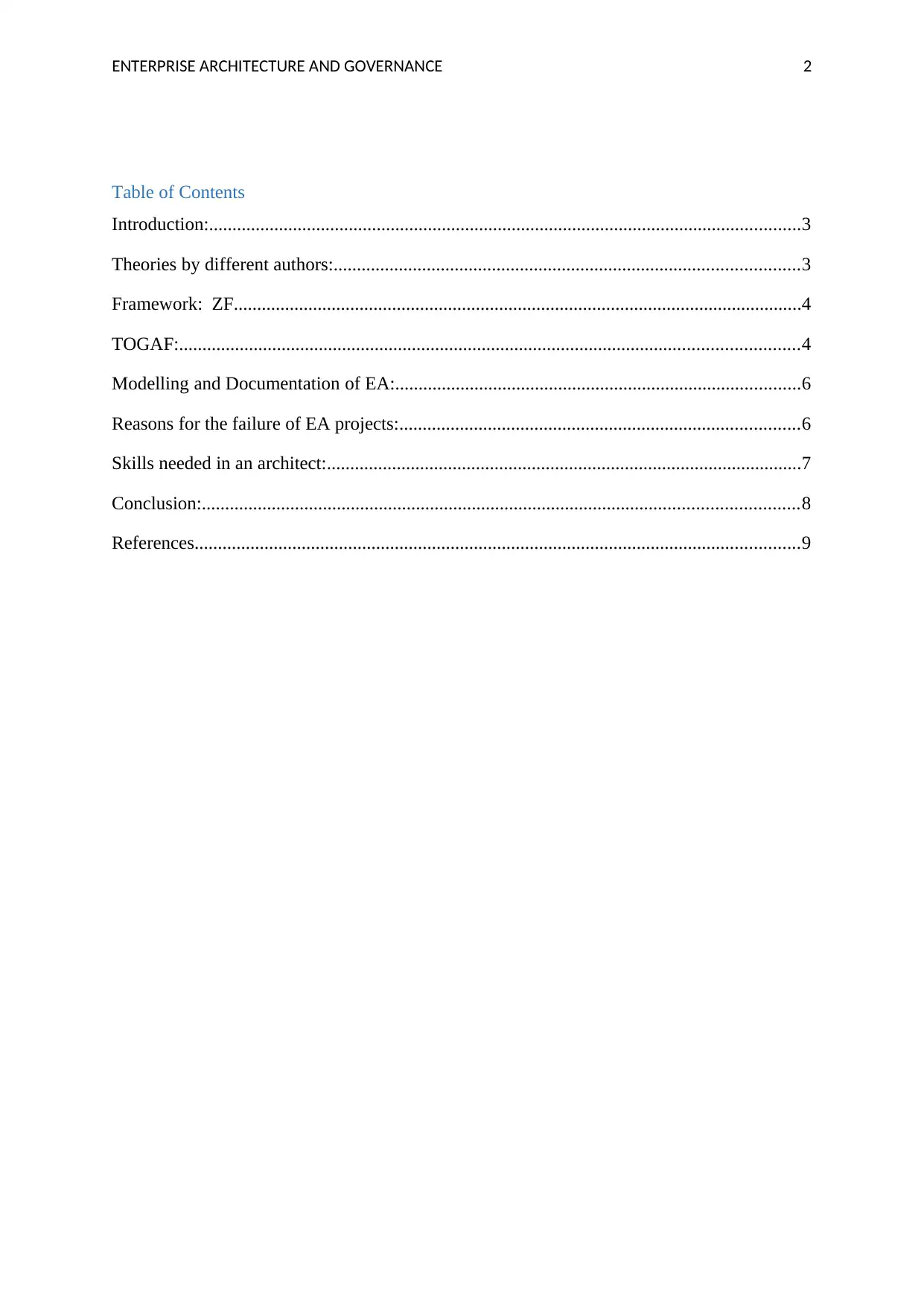
ENTERPRISE ARCHITECTURE AND GOVERNANCE 2
Table of Contents
Introduction:...............................................................................................................................3
Theories by different authors:....................................................................................................3
Framework: ZF..........................................................................................................................4
TOGAF:.....................................................................................................................................4
Modelling and Documentation of EA:.......................................................................................6
Reasons for the failure of EA projects:......................................................................................6
Skills needed in an architect:......................................................................................................7
Conclusion:................................................................................................................................8
References..................................................................................................................................9
Table of Contents
Introduction:...............................................................................................................................3
Theories by different authors:....................................................................................................3
Framework: ZF..........................................................................................................................4
TOGAF:.....................................................................................................................................4
Modelling and Documentation of EA:.......................................................................................6
Reasons for the failure of EA projects:......................................................................................6
Skills needed in an architect:......................................................................................................7
Conclusion:................................................................................................................................8
References..................................................................................................................................9
⊘ This is a preview!⊘
Do you want full access?
Subscribe today to unlock all pages.

Trusted by 1+ million students worldwide
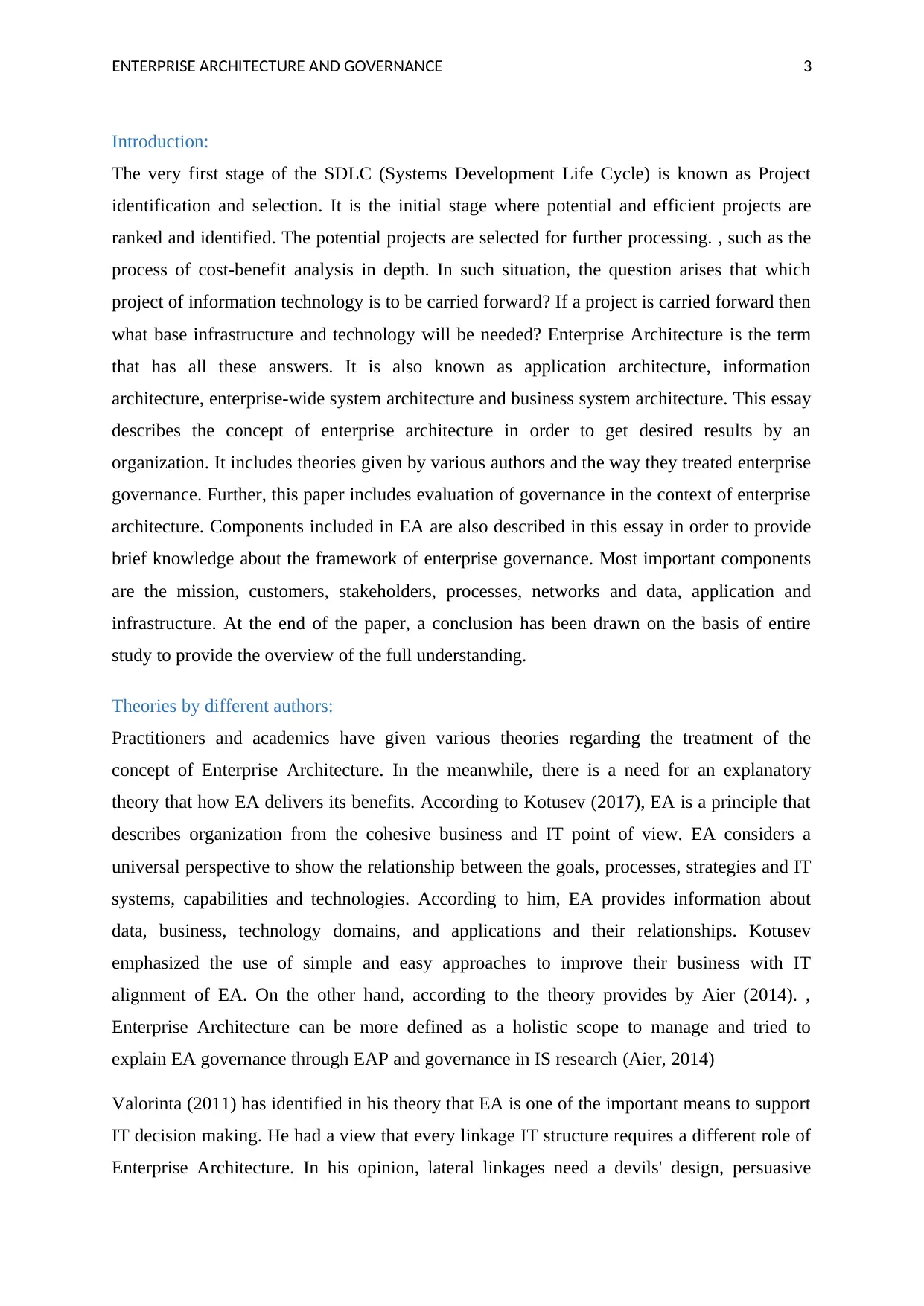
ENTERPRISE ARCHITECTURE AND GOVERNANCE 3
Introduction:
The very first stage of the SDLC (Systems Development Life Cycle) is known as Project
identification and selection. It is the initial stage where potential and efficient projects are
ranked and identified. The potential projects are selected for further processing. , such as the
process of cost-benefit analysis in depth. In such situation, the question arises that which
project of information technology is to be carried forward? If a project is carried forward then
what base infrastructure and technology will be needed? Enterprise Architecture is the term
that has all these answers. It is also known as application architecture, information
architecture, enterprise-wide system architecture and business system architecture. This essay
describes the concept of enterprise architecture in order to get desired results by an
organization. It includes theories given by various authors and the way they treated enterprise
governance. Further, this paper includes evaluation of governance in the context of enterprise
architecture. Components included in EA are also described in this essay in order to provide
brief knowledge about the framework of enterprise governance. Most important components
are the mission, customers, stakeholders, processes, networks and data, application and
infrastructure. At the end of the paper, a conclusion has been drawn on the basis of entire
study to provide the overview of the full understanding.
Theories by different authors:
Practitioners and academics have given various theories regarding the treatment of the
concept of Enterprise Architecture. In the meanwhile, there is a need for an explanatory
theory that how EA delivers its benefits. According to Kotusev (2017), EA is a principle that
describes organization from the cohesive business and IT point of view. EA considers a
universal perspective to show the relationship between the goals, processes, strategies and IT
systems, capabilities and technologies. According to him, EA provides information about
data, business, technology domains, and applications and their relationships. Kotusev
emphasized the use of simple and easy approaches to improve their business with IT
alignment of EA. On the other hand, according to the theory provides by Aier (2014). ,
Enterprise Architecture can be more defined as a holistic scope to manage and tried to
explain EA governance through EAP and governance in IS research (Aier, 2014)
Valorinta (2011) has identified in his theory that EA is one of the important means to support
IT decision making. He had a view that every linkage IT structure requires a different role of
Enterprise Architecture. In his opinion, lateral linkages need a devils' design, persuasive
Introduction:
The very first stage of the SDLC (Systems Development Life Cycle) is known as Project
identification and selection. It is the initial stage where potential and efficient projects are
ranked and identified. The potential projects are selected for further processing. , such as the
process of cost-benefit analysis in depth. In such situation, the question arises that which
project of information technology is to be carried forward? If a project is carried forward then
what base infrastructure and technology will be needed? Enterprise Architecture is the term
that has all these answers. It is also known as application architecture, information
architecture, enterprise-wide system architecture and business system architecture. This essay
describes the concept of enterprise architecture in order to get desired results by an
organization. It includes theories given by various authors and the way they treated enterprise
governance. Further, this paper includes evaluation of governance in the context of enterprise
architecture. Components included in EA are also described in this essay in order to provide
brief knowledge about the framework of enterprise governance. Most important components
are the mission, customers, stakeholders, processes, networks and data, application and
infrastructure. At the end of the paper, a conclusion has been drawn on the basis of entire
study to provide the overview of the full understanding.
Theories by different authors:
Practitioners and academics have given various theories regarding the treatment of the
concept of Enterprise Architecture. In the meanwhile, there is a need for an explanatory
theory that how EA delivers its benefits. According to Kotusev (2017), EA is a principle that
describes organization from the cohesive business and IT point of view. EA considers a
universal perspective to show the relationship between the goals, processes, strategies and IT
systems, capabilities and technologies. According to him, EA provides information about
data, business, technology domains, and applications and their relationships. Kotusev
emphasized the use of simple and easy approaches to improve their business with IT
alignment of EA. On the other hand, according to the theory provides by Aier (2014). ,
Enterprise Architecture can be more defined as a holistic scope to manage and tried to
explain EA governance through EAP and governance in IS research (Aier, 2014)
Valorinta (2011) has identified in his theory that EA is one of the important means to support
IT decision making. He had a view that every linkage IT structure requires a different role of
Enterprise Architecture. In his opinion, lateral linkages need a devils' design, persuasive
Paraphrase This Document
Need a fresh take? Get an instant paraphrase of this document with our AI Paraphraser
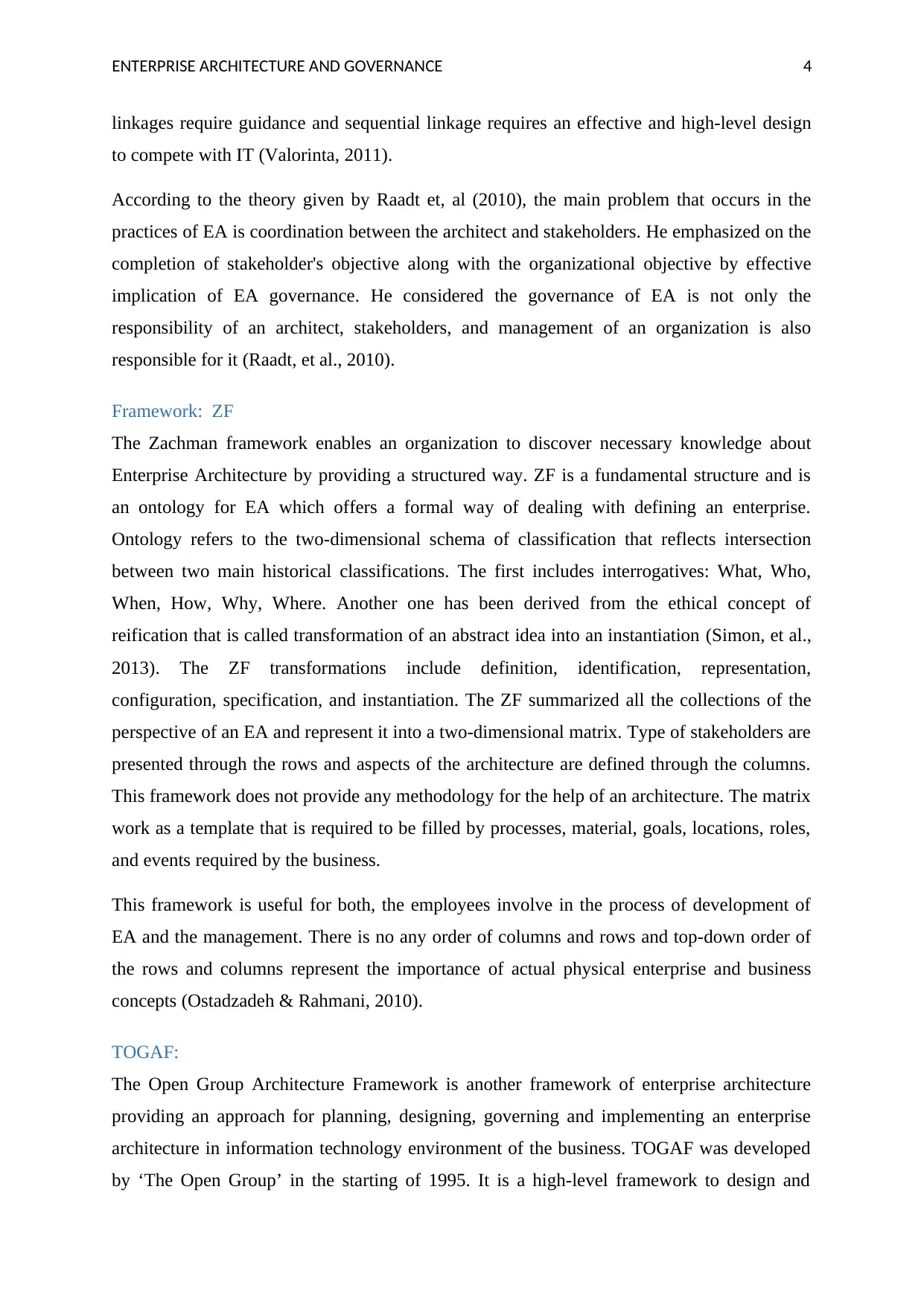
ENTERPRISE ARCHITECTURE AND GOVERNANCE 4
linkages require guidance and sequential linkage requires an effective and high-level design
to compete with IT (Valorinta, 2011).
According to the theory given by Raadt et, al (2010), the main problem that occurs in the
practices of EA is coordination between the architect and stakeholders. He emphasized on the
completion of stakeholder's objective along with the organizational objective by effective
implication of EA governance. He considered the governance of EA is not only the
responsibility of an architect, stakeholders, and management of an organization is also
responsible for it (Raadt, et al., 2010).
Framework: ZF
The Zachman framework enables an organization to discover necessary knowledge about
Enterprise Architecture by providing a structured way. ZF is a fundamental structure and is
an ontology for EA which offers a formal way of dealing with defining an enterprise.
Ontology refers to the two-dimensional schema of classification that reflects intersection
between two main historical classifications. The first includes interrogatives: What, Who,
When, How, Why, Where. Another one has been derived from the ethical concept of
reification that is called transformation of an abstract idea into an instantiation (Simon, et al.,
2013). The ZF transformations include definition, identification, representation,
configuration, specification, and instantiation. The ZF summarized all the collections of the
perspective of an EA and represent it into a two-dimensional matrix. Type of stakeholders are
presented through the rows and aspects of the architecture are defined through the columns.
This framework does not provide any methodology for the help of an architecture. The matrix
work as a template that is required to be filled by processes, material, goals, locations, roles,
and events required by the business.
This framework is useful for both, the employees involve in the process of development of
EA and the management. There is no any order of columns and rows and top-down order of
the rows and columns represent the importance of actual physical enterprise and business
concepts (Ostadzadeh & Rahmani, 2010).
TOGAF:
The Open Group Architecture Framework is another framework of enterprise architecture
providing an approach for planning, designing, governing and implementing an enterprise
architecture in information technology environment of the business. TOGAF was developed
by ‘The Open Group’ in the starting of 1995. It is a high-level framework to design and
linkages require guidance and sequential linkage requires an effective and high-level design
to compete with IT (Valorinta, 2011).
According to the theory given by Raadt et, al (2010), the main problem that occurs in the
practices of EA is coordination between the architect and stakeholders. He emphasized on the
completion of stakeholder's objective along with the organizational objective by effective
implication of EA governance. He considered the governance of EA is not only the
responsibility of an architect, stakeholders, and management of an organization is also
responsible for it (Raadt, et al., 2010).
Framework: ZF
The Zachman framework enables an organization to discover necessary knowledge about
Enterprise Architecture by providing a structured way. ZF is a fundamental structure and is
an ontology for EA which offers a formal way of dealing with defining an enterprise.
Ontology refers to the two-dimensional schema of classification that reflects intersection
between two main historical classifications. The first includes interrogatives: What, Who,
When, How, Why, Where. Another one has been derived from the ethical concept of
reification that is called transformation of an abstract idea into an instantiation (Simon, et al.,
2013). The ZF transformations include definition, identification, representation,
configuration, specification, and instantiation. The ZF summarized all the collections of the
perspective of an EA and represent it into a two-dimensional matrix. Type of stakeholders are
presented through the rows and aspects of the architecture are defined through the columns.
This framework does not provide any methodology for the help of an architecture. The matrix
work as a template that is required to be filled by processes, material, goals, locations, roles,
and events required by the business.
This framework is useful for both, the employees involve in the process of development of
EA and the management. There is no any order of columns and rows and top-down order of
the rows and columns represent the importance of actual physical enterprise and business
concepts (Ostadzadeh & Rahmani, 2010).
TOGAF:
The Open Group Architecture Framework is another framework of enterprise architecture
providing an approach for planning, designing, governing and implementing an enterprise
architecture in information technology environment of the business. TOGAF was developed
by ‘The Open Group’ in the starting of 1995. It is a high-level framework to design and
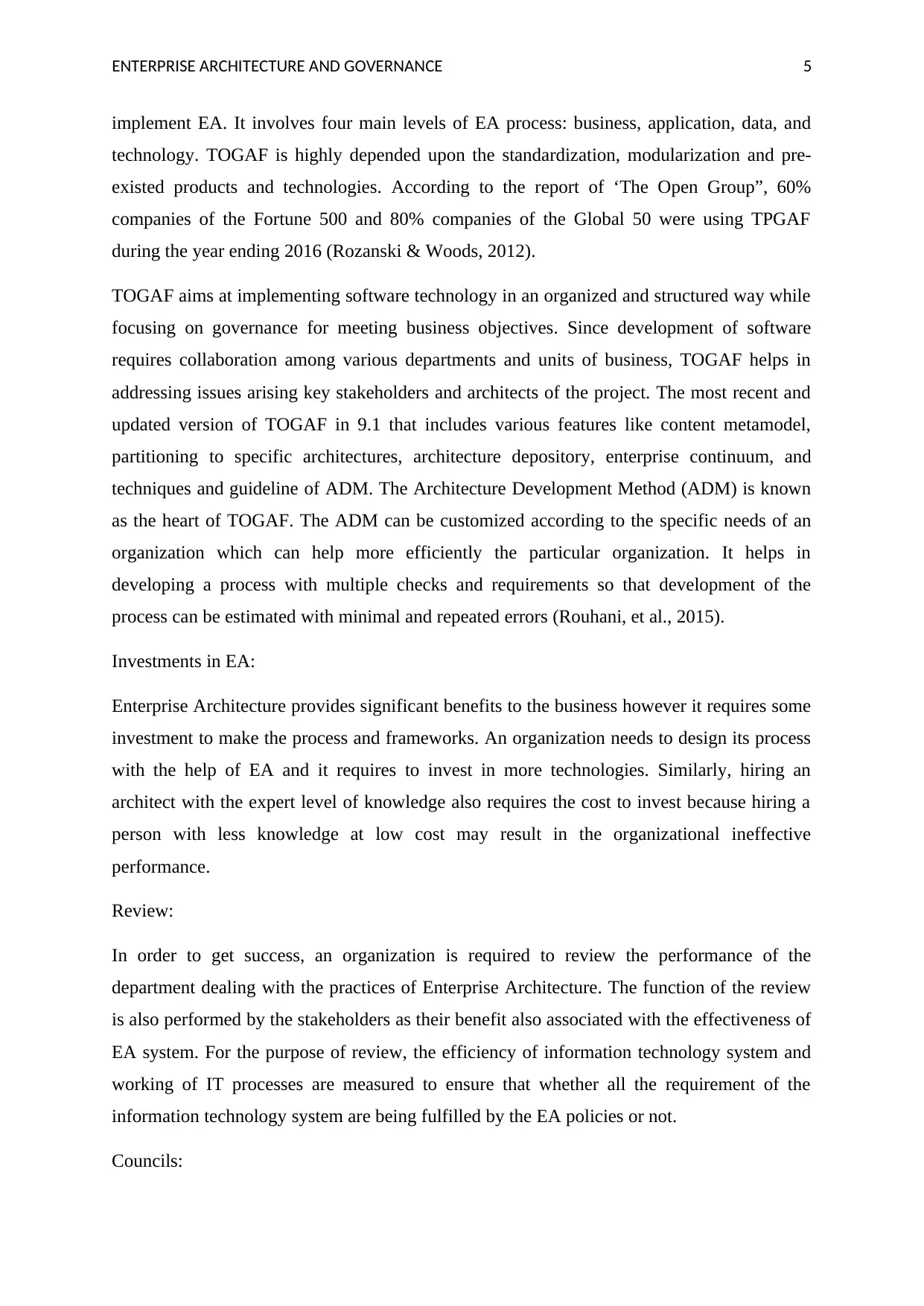
ENTERPRISE ARCHITECTURE AND GOVERNANCE 5
implement EA. It involves four main levels of EA process: business, application, data, and
technology. TOGAF is highly depended upon the standardization, modularization and pre-
existed products and technologies. According to the report of ‘The Open Group”, 60%
companies of the Fortune 500 and 80% companies of the Global 50 were using TPGAF
during the year ending 2016 (Rozanski & Woods, 2012).
TOGAF aims at implementing software technology in an organized and structured way while
focusing on governance for meeting business objectives. Since development of software
requires collaboration among various departments and units of business, TOGAF helps in
addressing issues arising key stakeholders and architects of the project. The most recent and
updated version of TOGAF in 9.1 that includes various features like content metamodel,
partitioning to specific architectures, architecture depository, enterprise continuum, and
techniques and guideline of ADM. The Architecture Development Method (ADM) is known
as the heart of TOGAF. The ADM can be customized according to the specific needs of an
organization which can help more efficiently the particular organization. It helps in
developing a process with multiple checks and requirements so that development of the
process can be estimated with minimal and repeated errors (Rouhani, et al., 2015).
Investments in EA:
Enterprise Architecture provides significant benefits to the business however it requires some
investment to make the process and frameworks. An organization needs to design its process
with the help of EA and it requires to invest in more technologies. Similarly, hiring an
architect with the expert level of knowledge also requires the cost to invest because hiring a
person with less knowledge at low cost may result in the organizational ineffective
performance.
Review:
In order to get success, an organization is required to review the performance of the
department dealing with the practices of Enterprise Architecture. The function of the review
is also performed by the stakeholders as their benefit also associated with the effectiveness of
EA system. For the purpose of review, the efficiency of information technology system and
working of IT processes are measured to ensure that whether all the requirement of the
information technology system are being fulfilled by the EA policies or not.
Councils:
implement EA. It involves four main levels of EA process: business, application, data, and
technology. TOGAF is highly depended upon the standardization, modularization and pre-
existed products and technologies. According to the report of ‘The Open Group”, 60%
companies of the Fortune 500 and 80% companies of the Global 50 were using TPGAF
during the year ending 2016 (Rozanski & Woods, 2012).
TOGAF aims at implementing software technology in an organized and structured way while
focusing on governance for meeting business objectives. Since development of software
requires collaboration among various departments and units of business, TOGAF helps in
addressing issues arising key stakeholders and architects of the project. The most recent and
updated version of TOGAF in 9.1 that includes various features like content metamodel,
partitioning to specific architectures, architecture depository, enterprise continuum, and
techniques and guideline of ADM. The Architecture Development Method (ADM) is known
as the heart of TOGAF. The ADM can be customized according to the specific needs of an
organization which can help more efficiently the particular organization. It helps in
developing a process with multiple checks and requirements so that development of the
process can be estimated with minimal and repeated errors (Rouhani, et al., 2015).
Investments in EA:
Enterprise Architecture provides significant benefits to the business however it requires some
investment to make the process and frameworks. An organization needs to design its process
with the help of EA and it requires to invest in more technologies. Similarly, hiring an
architect with the expert level of knowledge also requires the cost to invest because hiring a
person with less knowledge at low cost may result in the organizational ineffective
performance.
Review:
In order to get success, an organization is required to review the performance of the
department dealing with the practices of Enterprise Architecture. The function of the review
is also performed by the stakeholders as their benefit also associated with the effectiveness of
EA system. For the purpose of review, the efficiency of information technology system and
working of IT processes are measured to ensure that whether all the requirement of the
information technology system are being fulfilled by the EA policies or not.
Councils:
⊘ This is a preview!⊘
Do you want full access?
Subscribe today to unlock all pages.

Trusted by 1+ million students worldwide
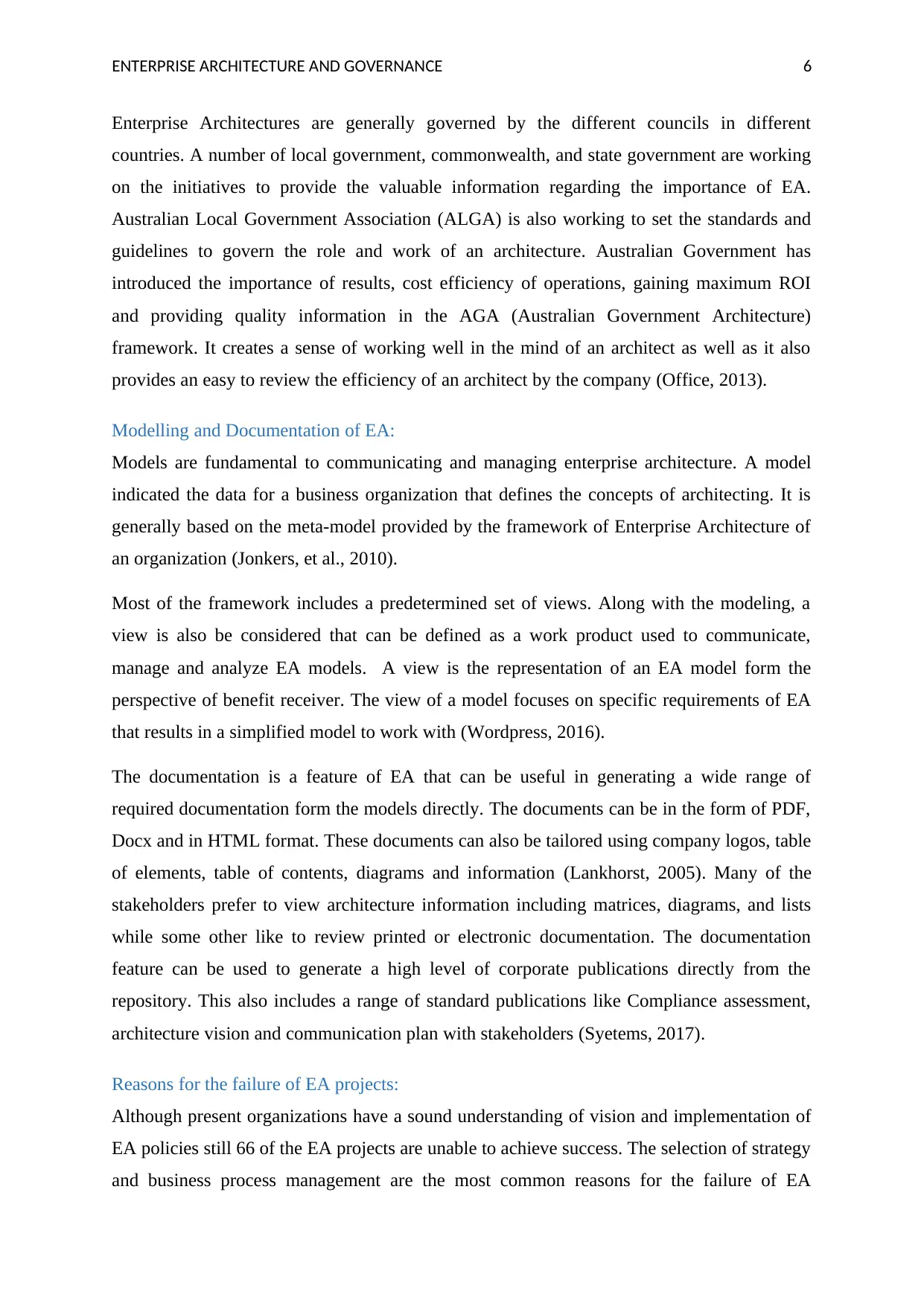
ENTERPRISE ARCHITECTURE AND GOVERNANCE 6
Enterprise Architectures are generally governed by the different councils in different
countries. A number of local government, commonwealth, and state government are working
on the initiatives to provide the valuable information regarding the importance of EA.
Australian Local Government Association (ALGA) is also working to set the standards and
guidelines to govern the role and work of an architecture. Australian Government has
introduced the importance of results, cost efficiency of operations, gaining maximum ROI
and providing quality information in the AGA (Australian Government Architecture)
framework. It creates a sense of working well in the mind of an architect as well as it also
provides an easy to review the efficiency of an architect by the company (Office, 2013).
Modelling and Documentation of EA:
Models are fundamental to communicating and managing enterprise architecture. A model
indicated the data for a business organization that defines the concepts of architecting. It is
generally based on the meta-model provided by the framework of Enterprise Architecture of
an organization (Jonkers, et al., 2010).
Most of the framework includes a predetermined set of views. Along with the modeling, a
view is also be considered that can be defined as a work product used to communicate,
manage and analyze EA models. A view is the representation of an EA model form the
perspective of benefit receiver. The view of a model focuses on specific requirements of EA
that results in a simplified model to work with (Wordpress, 2016).
The documentation is a feature of EA that can be useful in generating a wide range of
required documentation form the models directly. The documents can be in the form of PDF,
Docx and in HTML format. These documents can also be tailored using company logos, table
of elements, table of contents, diagrams and information (Lankhorst, 2005). Many of the
stakeholders prefer to view architecture information including matrices, diagrams, and lists
while some other like to review printed or electronic documentation. The documentation
feature can be used to generate a high level of corporate publications directly from the
repository. This also includes a range of standard publications like Compliance assessment,
architecture vision and communication plan with stakeholders (Syetems, 2017).
Reasons for the failure of EA projects:
Although present organizations have a sound understanding of vision and implementation of
EA policies still 66 of the EA projects are unable to achieve success. The selection of strategy
and business process management are the most common reasons for the failure of EA
Enterprise Architectures are generally governed by the different councils in different
countries. A number of local government, commonwealth, and state government are working
on the initiatives to provide the valuable information regarding the importance of EA.
Australian Local Government Association (ALGA) is also working to set the standards and
guidelines to govern the role and work of an architecture. Australian Government has
introduced the importance of results, cost efficiency of operations, gaining maximum ROI
and providing quality information in the AGA (Australian Government Architecture)
framework. It creates a sense of working well in the mind of an architect as well as it also
provides an easy to review the efficiency of an architect by the company (Office, 2013).
Modelling and Documentation of EA:
Models are fundamental to communicating and managing enterprise architecture. A model
indicated the data for a business organization that defines the concepts of architecting. It is
generally based on the meta-model provided by the framework of Enterprise Architecture of
an organization (Jonkers, et al., 2010).
Most of the framework includes a predetermined set of views. Along with the modeling, a
view is also be considered that can be defined as a work product used to communicate,
manage and analyze EA models. A view is the representation of an EA model form the
perspective of benefit receiver. The view of a model focuses on specific requirements of EA
that results in a simplified model to work with (Wordpress, 2016).
The documentation is a feature of EA that can be useful in generating a wide range of
required documentation form the models directly. The documents can be in the form of PDF,
Docx and in HTML format. These documents can also be tailored using company logos, table
of elements, table of contents, diagrams and information (Lankhorst, 2005). Many of the
stakeholders prefer to view architecture information including matrices, diagrams, and lists
while some other like to review printed or electronic documentation. The documentation
feature can be used to generate a high level of corporate publications directly from the
repository. This also includes a range of standard publications like Compliance assessment,
architecture vision and communication plan with stakeholders (Syetems, 2017).
Reasons for the failure of EA projects:
Although present organizations have a sound understanding of vision and implementation of
EA policies still 66 of the EA projects are unable to achieve success. The selection of strategy
and business process management are the most common reasons for the failure of EA
Paraphrase This Document
Need a fresh take? Get an instant paraphrase of this document with our AI Paraphraser
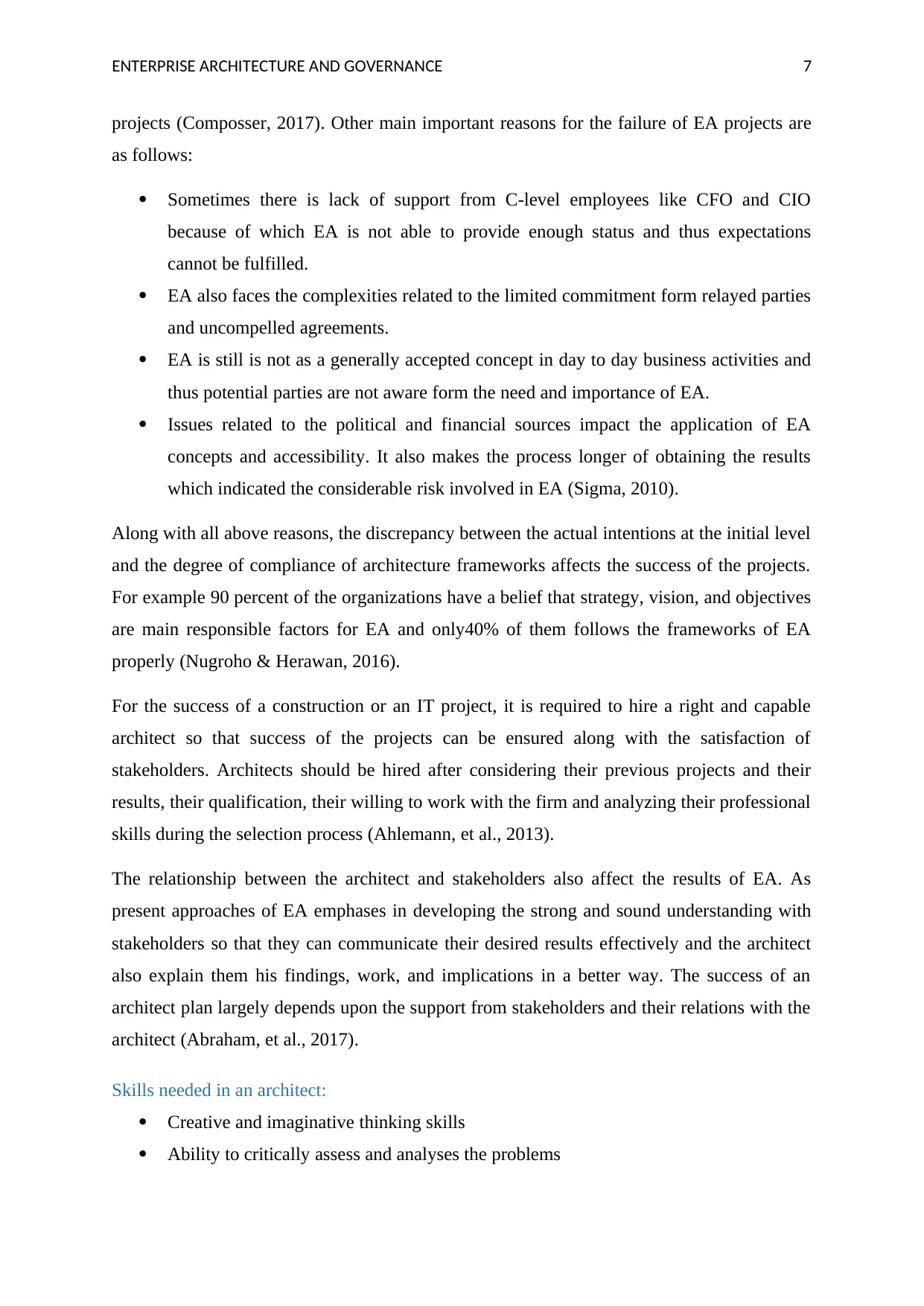
ENTERPRISE ARCHITECTURE AND GOVERNANCE 7
projects (Composser, 2017). Other main important reasons for the failure of EA projects are
as follows:
Sometimes there is lack of support from C-level employees like CFO and CIO
because of which EA is not able to provide enough status and thus expectations
cannot be fulfilled.
EA also faces the complexities related to the limited commitment form relayed parties
and uncompelled agreements.
EA is still is not as a generally accepted concept in day to day business activities and
thus potential parties are not aware form the need and importance of EA.
Issues related to the political and financial sources impact the application of EA
concepts and accessibility. It also makes the process longer of obtaining the results
which indicated the considerable risk involved in EA (Sigma, 2010).
Along with all above reasons, the discrepancy between the actual intentions at the initial level
and the degree of compliance of architecture frameworks affects the success of the projects.
For example 90 percent of the organizations have a belief that strategy, vision, and objectives
are main responsible factors for EA and only40% of them follows the frameworks of EA
properly (Nugroho & Herawan, 2016).
For the success of a construction or an IT project, it is required to hire a right and capable
architect so that success of the projects can be ensured along with the satisfaction of
stakeholders. Architects should be hired after considering their previous projects and their
results, their qualification, their willing to work with the firm and analyzing their professional
skills during the selection process (Ahlemann, et al., 2013).
The relationship between the architect and stakeholders also affect the results of EA. As
present approaches of EA emphases in developing the strong and sound understanding with
stakeholders so that they can communicate their desired results effectively and the architect
also explain them his findings, work, and implications in a better way. The success of an
architect plan largely depends upon the support from stakeholders and their relations with the
architect (Abraham, et al., 2017).
Skills needed in an architect:
Creative and imaginative thinking skills
Ability to critically assess and analyses the problems
projects (Composser, 2017). Other main important reasons for the failure of EA projects are
as follows:
Sometimes there is lack of support from C-level employees like CFO and CIO
because of which EA is not able to provide enough status and thus expectations
cannot be fulfilled.
EA also faces the complexities related to the limited commitment form relayed parties
and uncompelled agreements.
EA is still is not as a generally accepted concept in day to day business activities and
thus potential parties are not aware form the need and importance of EA.
Issues related to the political and financial sources impact the application of EA
concepts and accessibility. It also makes the process longer of obtaining the results
which indicated the considerable risk involved in EA (Sigma, 2010).
Along with all above reasons, the discrepancy between the actual intentions at the initial level
and the degree of compliance of architecture frameworks affects the success of the projects.
For example 90 percent of the organizations have a belief that strategy, vision, and objectives
are main responsible factors for EA and only40% of them follows the frameworks of EA
properly (Nugroho & Herawan, 2016).
For the success of a construction or an IT project, it is required to hire a right and capable
architect so that success of the projects can be ensured along with the satisfaction of
stakeholders. Architects should be hired after considering their previous projects and their
results, their qualification, their willing to work with the firm and analyzing their professional
skills during the selection process (Ahlemann, et al., 2013).
The relationship between the architect and stakeholders also affect the results of EA. As
present approaches of EA emphases in developing the strong and sound understanding with
stakeholders so that they can communicate their desired results effectively and the architect
also explain them his findings, work, and implications in a better way. The success of an
architect plan largely depends upon the support from stakeholders and their relations with the
architect (Abraham, et al., 2017).
Skills needed in an architect:
Creative and imaginative thinking skills
Ability to critically assess and analyses the problems
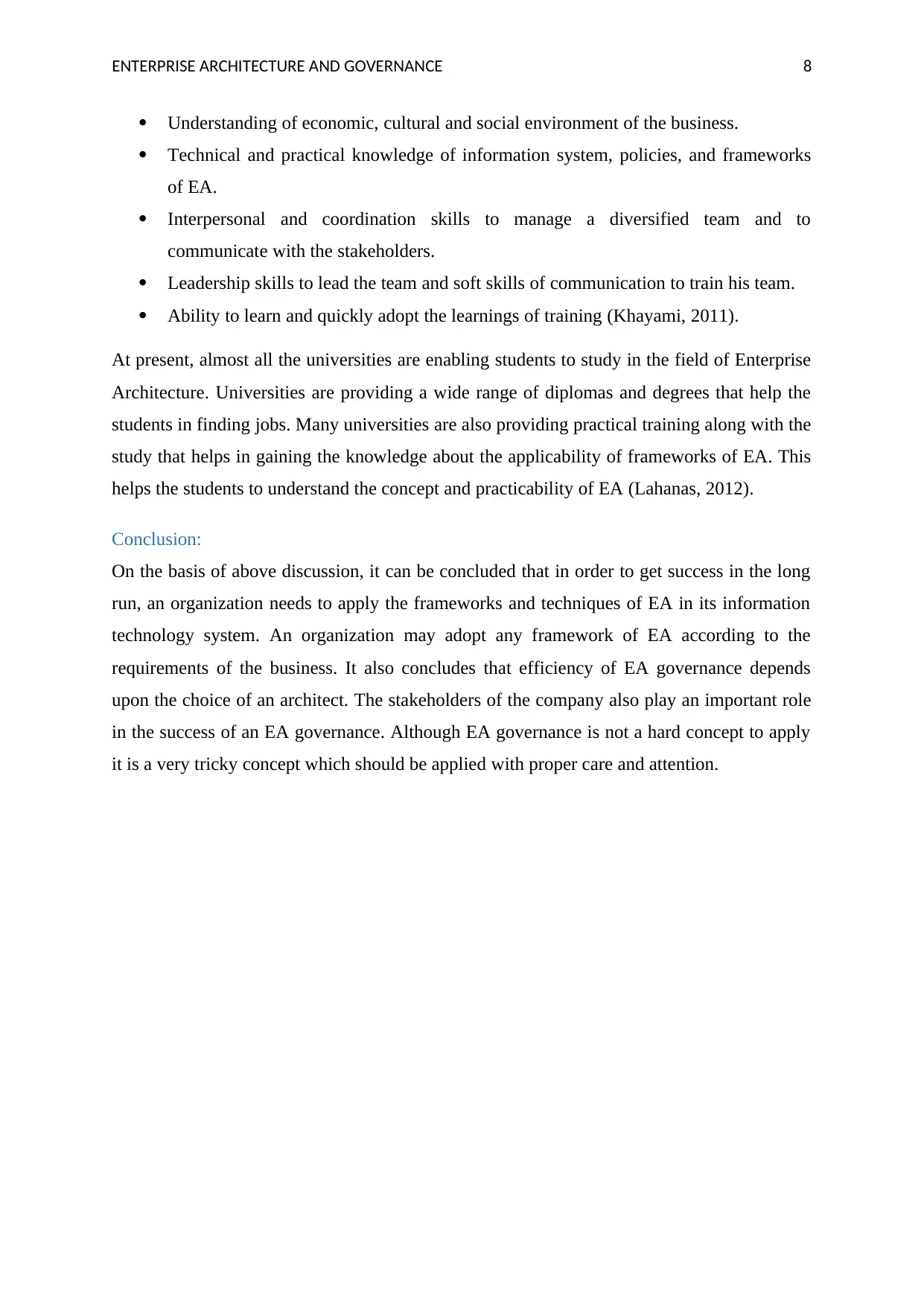
ENTERPRISE ARCHITECTURE AND GOVERNANCE 8
Understanding of economic, cultural and social environment of the business.
Technical and practical knowledge of information system, policies, and frameworks
of EA.
Interpersonal and coordination skills to manage a diversified team and to
communicate with the stakeholders.
Leadership skills to lead the team and soft skills of communication to train his team.
Ability to learn and quickly adopt the learnings of training (Khayami, 2011).
At present, almost all the universities are enabling students to study in the field of Enterprise
Architecture. Universities are providing a wide range of diplomas and degrees that help the
students in finding jobs. Many universities are also providing practical training along with the
study that helps in gaining the knowledge about the applicability of frameworks of EA. This
helps the students to understand the concept and practicability of EA (Lahanas, 2012).
Conclusion:
On the basis of above discussion, it can be concluded that in order to get success in the long
run, an organization needs to apply the frameworks and techniques of EA in its information
technology system. An organization may adopt any framework of EA according to the
requirements of the business. It also concludes that efficiency of EA governance depends
upon the choice of an architect. The stakeholders of the company also play an important role
in the success of an EA governance. Although EA governance is not a hard concept to apply
it is a very tricky concept which should be applied with proper care and attention.
Understanding of economic, cultural and social environment of the business.
Technical and practical knowledge of information system, policies, and frameworks
of EA.
Interpersonal and coordination skills to manage a diversified team and to
communicate with the stakeholders.
Leadership skills to lead the team and soft skills of communication to train his team.
Ability to learn and quickly adopt the learnings of training (Khayami, 2011).
At present, almost all the universities are enabling students to study in the field of Enterprise
Architecture. Universities are providing a wide range of diplomas and degrees that help the
students in finding jobs. Many universities are also providing practical training along with the
study that helps in gaining the knowledge about the applicability of frameworks of EA. This
helps the students to understand the concept and practicability of EA (Lahanas, 2012).
Conclusion:
On the basis of above discussion, it can be concluded that in order to get success in the long
run, an organization needs to apply the frameworks and techniques of EA in its information
technology system. An organization may adopt any framework of EA according to the
requirements of the business. It also concludes that efficiency of EA governance depends
upon the choice of an architect. The stakeholders of the company also play an important role
in the success of an EA governance. Although EA governance is not a hard concept to apply
it is a very tricky concept which should be applied with proper care and attention.
⊘ This is a preview!⊘
Do you want full access?
Subscribe today to unlock all pages.

Trusted by 1+ million students worldwide
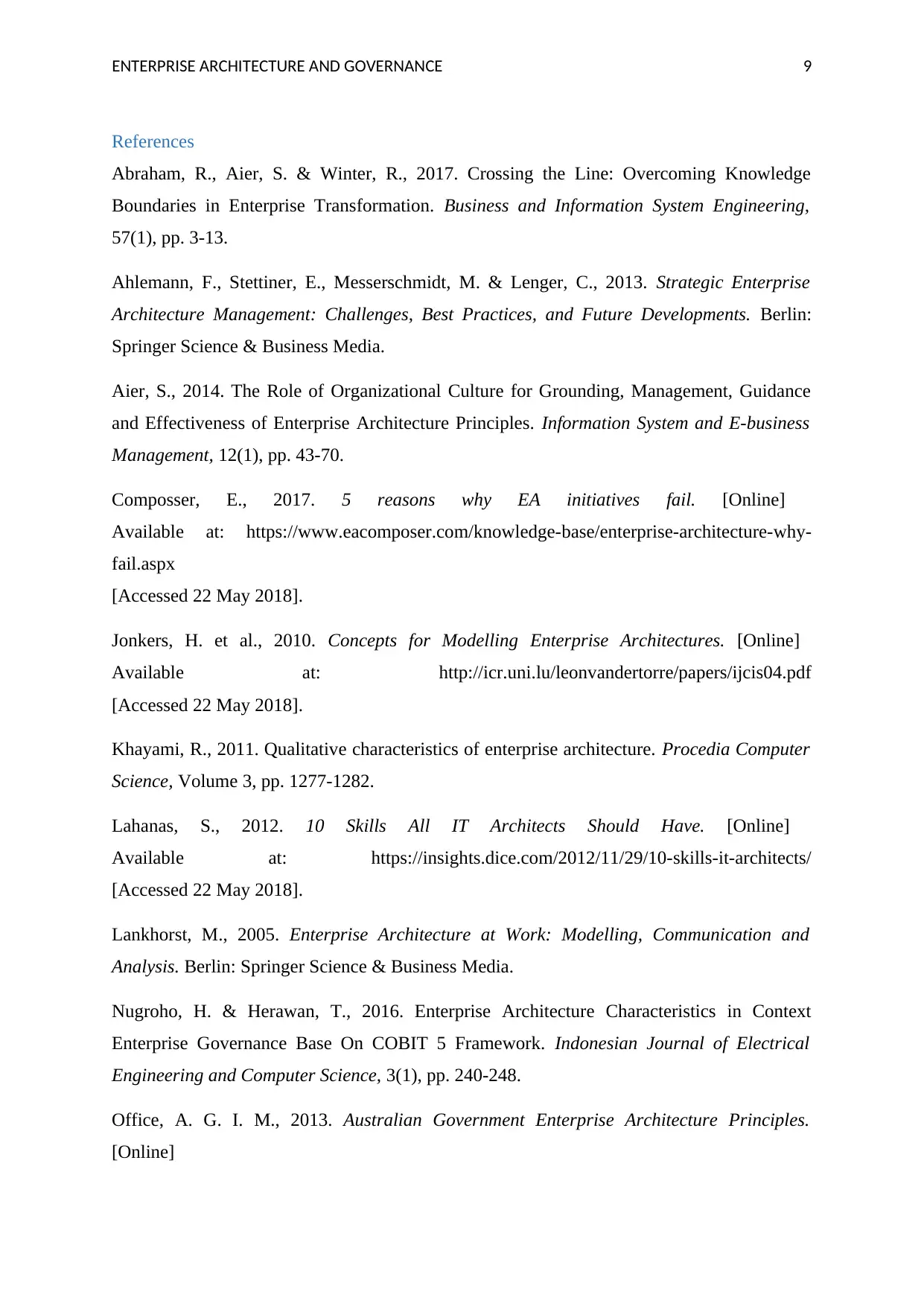
ENTERPRISE ARCHITECTURE AND GOVERNANCE 9
References
Abraham, R., Aier, S. & Winter, R., 2017. Crossing the Line: Overcoming Knowledge
Boundaries in Enterprise Transformation. Business and Information System Engineering,
57(1), pp. 3-13.
Ahlemann, F., Stettiner, E., Messerschmidt, M. & Lenger, C., 2013. Strategic Enterprise
Architecture Management: Challenges, Best Practices, and Future Developments. Berlin:
Springer Science & Business Media.
Aier, S., 2014. The Role of Organizational Culture for Grounding, Management, Guidance
and Effectiveness of Enterprise Architecture Principles. Information System and E-business
Management, 12(1), pp. 43-70.
Composser, E., 2017. 5 reasons why EA initiatives fail. [Online]
Available at: https://www.eacomposer.com/knowledge-base/enterprise-architecture-why-
fail.aspx
[Accessed 22 May 2018].
Jonkers, H. et al., 2010. Concepts for Modelling Enterprise Architectures. [Online]
Available at: http://icr.uni.lu/leonvandertorre/papers/ijcis04.pdf
[Accessed 22 May 2018].
Khayami, R., 2011. Qualitative characteristics of enterprise architecture. Procedia Computer
Science, Volume 3, pp. 1277-1282.
Lahanas, S., 2012. 10 Skills All IT Architects Should Have. [Online]
Available at: https://insights.dice.com/2012/11/29/10-skills-it-architects/
[Accessed 22 May 2018].
Lankhorst, M., 2005. Enterprise Architecture at Work: Modelling, Communication and
Analysis. Berlin: Springer Science & Business Media.
Nugroho, H. & Herawan, T., 2016. Enterprise Architecture Characteristics in Context
Enterprise Governance Base On COBIT 5 Framework. Indonesian Journal of Electrical
Engineering and Computer Science, 3(1), pp. 240-248.
Office, A. G. I. M., 2013. Australian Government Enterprise Architecture Principles.
[Online]
References
Abraham, R., Aier, S. & Winter, R., 2017. Crossing the Line: Overcoming Knowledge
Boundaries in Enterprise Transformation. Business and Information System Engineering,
57(1), pp. 3-13.
Ahlemann, F., Stettiner, E., Messerschmidt, M. & Lenger, C., 2013. Strategic Enterprise
Architecture Management: Challenges, Best Practices, and Future Developments. Berlin:
Springer Science & Business Media.
Aier, S., 2014. The Role of Organizational Culture for Grounding, Management, Guidance
and Effectiveness of Enterprise Architecture Principles. Information System and E-business
Management, 12(1), pp. 43-70.
Composser, E., 2017. 5 reasons why EA initiatives fail. [Online]
Available at: https://www.eacomposer.com/knowledge-base/enterprise-architecture-why-
fail.aspx
[Accessed 22 May 2018].
Jonkers, H. et al., 2010. Concepts for Modelling Enterprise Architectures. [Online]
Available at: http://icr.uni.lu/leonvandertorre/papers/ijcis04.pdf
[Accessed 22 May 2018].
Khayami, R., 2011. Qualitative characteristics of enterprise architecture. Procedia Computer
Science, Volume 3, pp. 1277-1282.
Lahanas, S., 2012. 10 Skills All IT Architects Should Have. [Online]
Available at: https://insights.dice.com/2012/11/29/10-skills-it-architects/
[Accessed 22 May 2018].
Lankhorst, M., 2005. Enterprise Architecture at Work: Modelling, Communication and
Analysis. Berlin: Springer Science & Business Media.
Nugroho, H. & Herawan, T., 2016. Enterprise Architecture Characteristics in Context
Enterprise Governance Base On COBIT 5 Framework. Indonesian Journal of Electrical
Engineering and Computer Science, 3(1), pp. 240-248.
Office, A. G. I. M., 2013. Australian Government Enterprise Architecture Principles.
[Online]
Paraphrase This Document
Need a fresh take? Get an instant paraphrase of this document with our AI Paraphraser
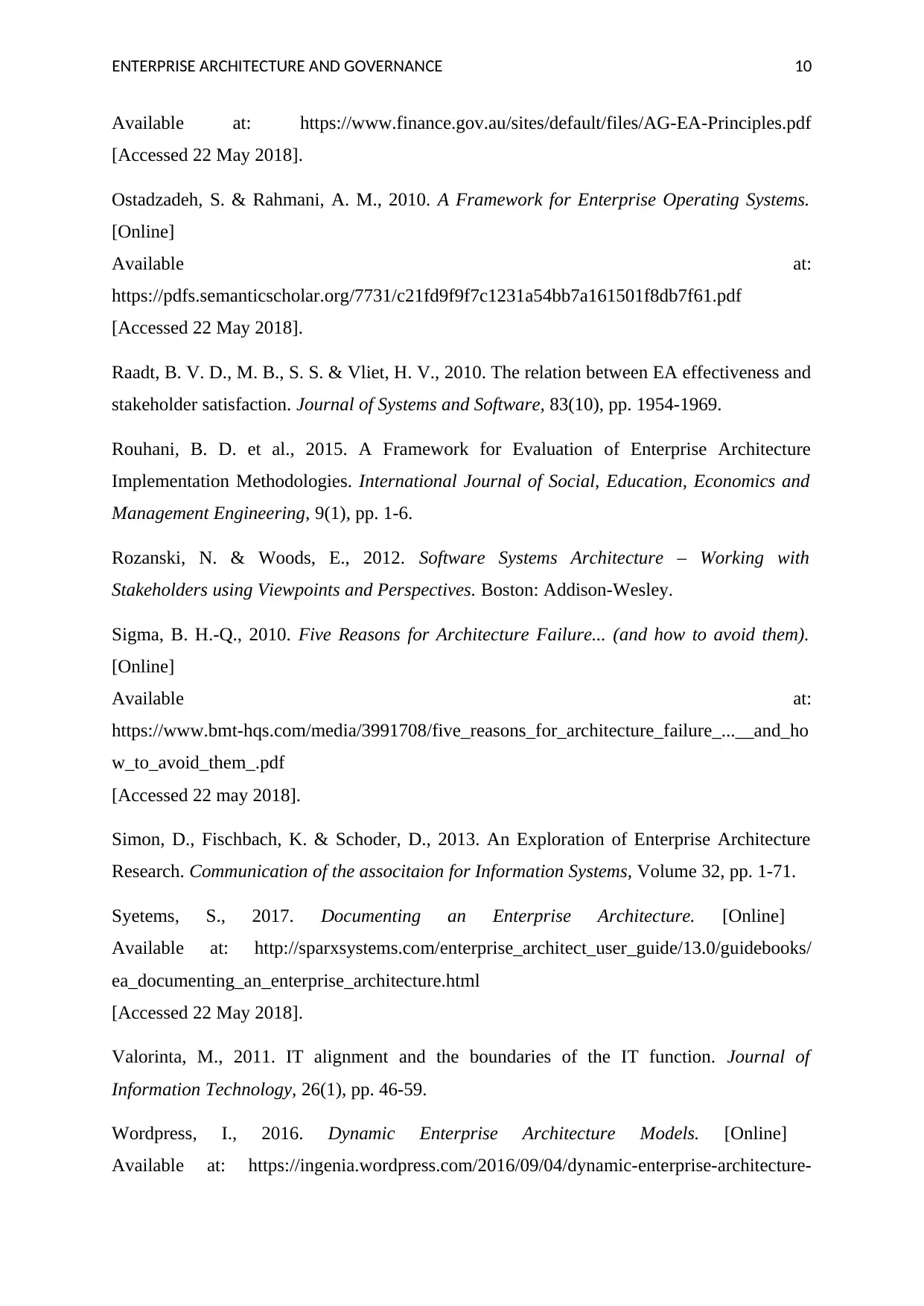
ENTERPRISE ARCHITECTURE AND GOVERNANCE 10
Available at: https://www.finance.gov.au/sites/default/files/AG-EA-Principles.pdf
[Accessed 22 May 2018].
Ostadzadeh, S. & Rahmani, A. M., 2010. A Framework for Enterprise Operating Systems.
[Online]
Available at:
https://pdfs.semanticscholar.org/7731/c21fd9f9f7c1231a54bb7a161501f8db7f61.pdf
[Accessed 22 May 2018].
Raadt, B. V. D., M. B., S. S. & Vliet, H. V., 2010. The relation between EA effectiveness and
stakeholder satisfaction. Journal of Systems and Software, 83(10), pp. 1954-1969.
Rouhani, B. D. et al., 2015. A Framework for Evaluation of Enterprise Architecture
Implementation Methodologies. International Journal of Social, Education, Economics and
Management Engineering, 9(1), pp. 1-6.
Rozanski, N. & Woods, E., 2012. Software Systems Architecture – Working with
Stakeholders using Viewpoints and Perspectives. Boston: Addison-Wesley.
Sigma, B. H.-Q., 2010. Five Reasons for Architecture Failure... (and how to avoid them).
[Online]
Available at:
https://www.bmt-hqs.com/media/3991708/five_reasons_for_architecture_failure_...__and_ho
w_to_avoid_them_.pdf
[Accessed 22 may 2018].
Simon, D., Fischbach, K. & Schoder, D., 2013. An Exploration of Enterprise Architecture
Research. Communication of the associtaion for Information Systems, Volume 32, pp. 1-71.
Syetems, S., 2017. Documenting an Enterprise Architecture. [Online]
Available at: http://sparxsystems.com/enterprise_architect_user_guide/13.0/guidebooks/
ea_documenting_an_enterprise_architecture.html
[Accessed 22 May 2018].
Valorinta, M., 2011. IT alignment and the boundaries of the IT function. Journal of
Information Technology, 26(1), pp. 46-59.
Wordpress, I., 2016. Dynamic Enterprise Architecture Models. [Online]
Available at: https://ingenia.wordpress.com/2016/09/04/dynamic-enterprise-architecture-
Available at: https://www.finance.gov.au/sites/default/files/AG-EA-Principles.pdf
[Accessed 22 May 2018].
Ostadzadeh, S. & Rahmani, A. M., 2010. A Framework for Enterprise Operating Systems.
[Online]
Available at:
https://pdfs.semanticscholar.org/7731/c21fd9f9f7c1231a54bb7a161501f8db7f61.pdf
[Accessed 22 May 2018].
Raadt, B. V. D., M. B., S. S. & Vliet, H. V., 2010. The relation between EA effectiveness and
stakeholder satisfaction. Journal of Systems and Software, 83(10), pp. 1954-1969.
Rouhani, B. D. et al., 2015. A Framework for Evaluation of Enterprise Architecture
Implementation Methodologies. International Journal of Social, Education, Economics and
Management Engineering, 9(1), pp. 1-6.
Rozanski, N. & Woods, E., 2012. Software Systems Architecture – Working with
Stakeholders using Viewpoints and Perspectives. Boston: Addison-Wesley.
Sigma, B. H.-Q., 2010. Five Reasons for Architecture Failure... (and how to avoid them).
[Online]
Available at:
https://www.bmt-hqs.com/media/3991708/five_reasons_for_architecture_failure_...__and_ho
w_to_avoid_them_.pdf
[Accessed 22 may 2018].
Simon, D., Fischbach, K. & Schoder, D., 2013. An Exploration of Enterprise Architecture
Research. Communication of the associtaion for Information Systems, Volume 32, pp. 1-71.
Syetems, S., 2017. Documenting an Enterprise Architecture. [Online]
Available at: http://sparxsystems.com/enterprise_architect_user_guide/13.0/guidebooks/
ea_documenting_an_enterprise_architecture.html
[Accessed 22 May 2018].
Valorinta, M., 2011. IT alignment and the boundaries of the IT function. Journal of
Information Technology, 26(1), pp. 46-59.
Wordpress, I., 2016. Dynamic Enterprise Architecture Models. [Online]
Available at: https://ingenia.wordpress.com/2016/09/04/dynamic-enterprise-architecture-
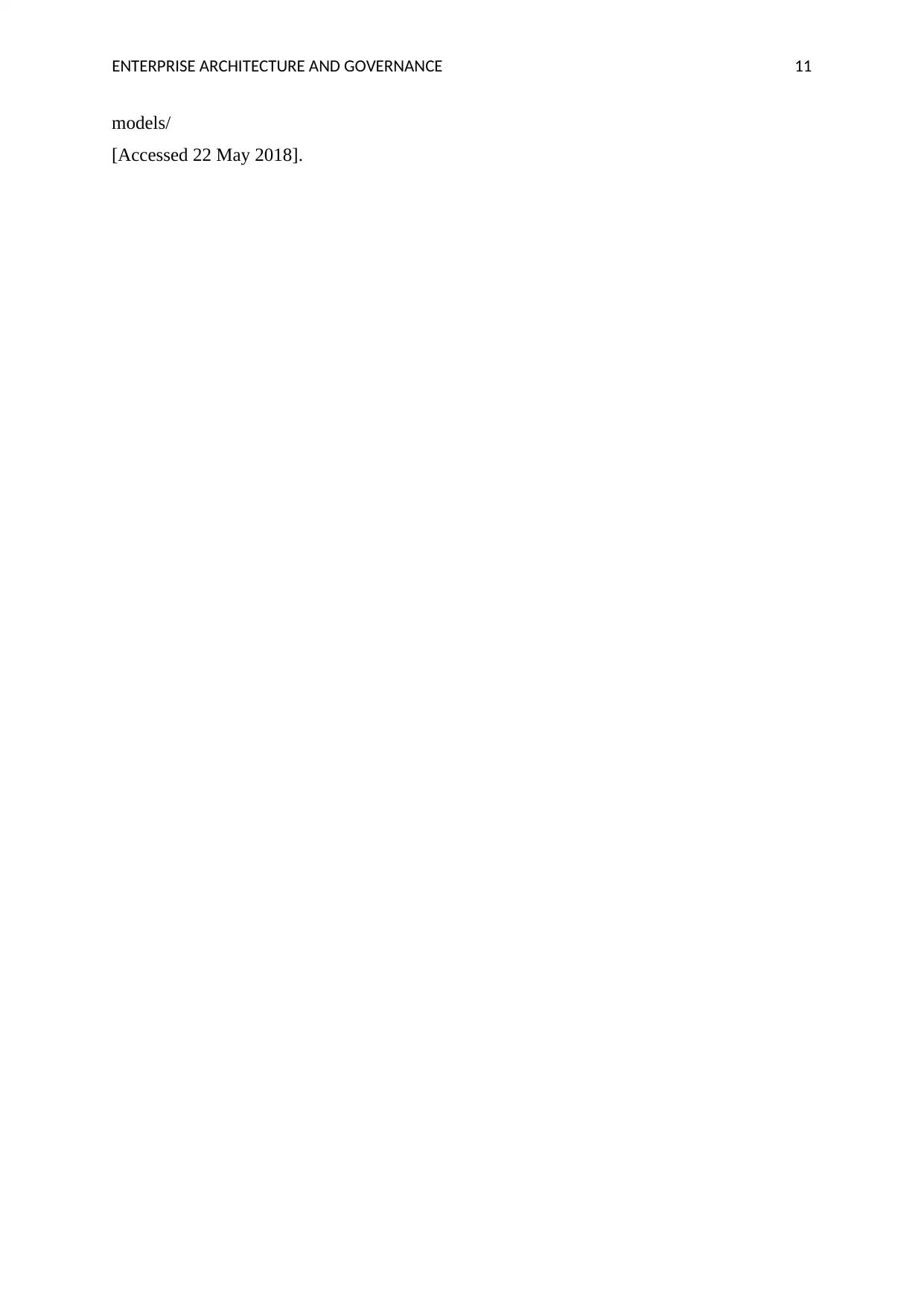
ENTERPRISE ARCHITECTURE AND GOVERNANCE 11
models/
[Accessed 22 May 2018].
models/
[Accessed 22 May 2018].
⊘ This is a preview!⊘
Do you want full access?
Subscribe today to unlock all pages.

Trusted by 1+ million students worldwide
1 out of 12
Related Documents
Your All-in-One AI-Powered Toolkit for Academic Success.
+13062052269
info@desklib.com
Available 24*7 on WhatsApp / Email
![[object Object]](/_next/static/media/star-bottom.7253800d.svg)
Unlock your academic potential
Copyright © 2020–2025 A2Z Services. All Rights Reserved. Developed and managed by ZUCOL.





